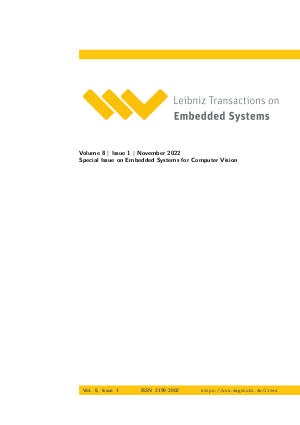Leibniz Transactions on Embedded Systems, Volume 8, Issue 1
LITES, Volume 8, Issue 1
-
Part of:
Volume:
LITES, Volume 8
Journal: Leibniz Transactions on Embedded Systems (LITES)

Special Issue
Special Issue on Embedded Systems for Computer VisionEditors
Publication Details
- published at: 2022-11-16
- Publisher: Schloss Dagstuhl – Leibniz-Zentrum für Informatik
- DBLP: db/journals/lites/lites8
Access Numbers
- Detailed Access Statistics available here
-
Total Document Accesses (updated on a weekly basis):
0PDF Downloads
Documents
LITES, Volume 8, Issue 1
Abstract
Cite as
LITES, Volume 8, Issue 1: Special Issue on Embedded Systems for Computer Vision, pp. 1-91, Schloss Dagstuhl – Leibniz-Zentrum für Informatik (2022)
Copy BibTex To Clipboard
@Article{LITES-v008-i001,
title = {{LITES, Volume 8, Issue 1}},
journal = {Leibniz Transactions on Embedded Systems},
pages = {1--91},
ISSN = {2199-2002},
year = {2022},
volume = {8},
number = {1},
publisher = {Schloss Dagstuhl -- Leibniz-Zentrum f{\"u}r Informatik},
address = {Dagstuhl, Germany},
URL = {https://drops-dev.dagstuhl.de/entities/document/10.4230/LITES-v008-i001},
doi = {10.4230/LITES-v008-i001},
annote = {Keywords: LITES, Volume 8, Issue 1}
}
Introduction to the Special Issue on Embedded Systems for Computer Vision
Abstract
Cite as
LITES, Volume 8, Issue 1: Special Issue on Embedded Systems for Computer Vision, pp. 0:i-0:viii, Schloss Dagstuhl – Leibniz-Zentrum für Informatik (2022)
Copy BibTex To Clipboard
@Article{chakraborty_et_al:LITES.8.1.0,
author = {Chakraborty, Samarjit and Rao, Qing},
title = {{Introduction to the Special Issue on Embedded Systems for Computer Vision}},
journal = {Leibniz Transactions on Embedded Systems},
pages = {00:1--00:8},
ISSN = {2199-2002},
year = {2022},
volume = {8},
number = {1},
publisher = {Schloss Dagstuhl -- Leibniz-Zentrum f{\"u}r Informatik},
address = {Dagstuhl, Germany},
URL = {https://drops-dev.dagstuhl.de/entities/document/10.4230/LITES.8.1.0},
doi = {10.4230/LITES.8.1.0},
annote = {Keywords: Embedded systems, Computer vision, Cyber-physical systems, Computer architecture}
}
Susceptibility to Image Resolution in Face Recognition and Training Strategies to Enhance Robustness
Abstract
Cite as
Martin Knoche, Stefan Hörmann, and Gerhard Rigoll. Susceptibility to Image Resolution in Face Recognition and Training Strategies to Enhance Robustness. In LITES, Volume 8, Issue 1 (2022): Special Issue on Embedded Systems for Computer Vision. Leibniz Transactions on Embedded Systems, Volume 8, Issue 1, pp. 01:1-01:20, Schloss Dagstuhl – Leibniz-Zentrum für Informatik (2022)
Copy BibTex To Clipboard
@Article{knoche_et_al:LITES.8.1.1,
author = {Knoche, Martin and H\"{o}rmann, Stefan and Rigoll, Gerhard},
title = {{Susceptibility to Image Resolution in Face Recognition and Training Strategies to Enhance Robustness}},
journal = {Leibniz Transactions on Embedded Systems},
pages = {01:1--01:20},
ISSN = {2199-2002},
year = {2022},
volume = {8},
number = {1},
publisher = {Schloss Dagstuhl -- Leibniz-Zentrum f{\"u}r Informatik},
address = {Dagstuhl, Germany},
URL = {https://drops-dev.dagstuhl.de/entities/document/10.4230/LITES.8.1.1},
doi = {10.4230/LITES.8.1.1},
annote = {Keywords: recognition, resolution, cross, face, identification}
}
Micro- and Macroscopic Road Traffic Analysis using Drone Image Data
Abstract
Cite as
Friedrich Kruber, Eduardo Sánchez Morales, Robin Egolf, Jonas Wurst, Samarjit Chakraborty, and Michael Botsch. Micro- and Macroscopic Road Traffic Analysis using Drone Image Data. In LITES, Volume 8, Issue 1 (2022): Special Issue on Embedded Systems for Computer Vision. Leibniz Transactions on Embedded Systems, Volume 8, Issue 1, pp. 02:1-02:27, Schloss Dagstuhl – Leibniz-Zentrum für Informatik (2022)
Copy BibTex To Clipboard
@Article{kruber_et_al:LITES.8.1.2,
author = {Kruber, Friedrich and S\'{a}nchez Morales, Eduardo and Egolf, Robin and Wurst, Jonas and Chakraborty, Samarjit and Botsch, Michael},
title = {{Micro- and Macroscopic Road Traffic Analysis using Drone Image Data}},
journal = {Leibniz Transactions on Embedded Systems},
pages = {02:1--02:27},
ISSN = {2199-2002},
year = {2022},
volume = {8},
number = {1},
publisher = {Schloss Dagstuhl -- Leibniz-Zentrum f{\"u}r Informatik},
address = {Dagstuhl, Germany},
URL = {https://drops-dev.dagstuhl.de/entities/document/10.4230/LITES.8.1.2},
doi = {10.4230/LITES.8.1.2},
annote = {Keywords: traffic data analysis, trajectory data, drone image data}
}
HW-Flow: A Multi-Abstraction Level HW-CNN Codesign Pruning Methodology
Abstract
Cite as
Manoj-Rohit Vemparala, Nael Fasfous, Alexander Frickenstein, Emanuele Valpreda, Manfredi Camalleri, Qi Zhao, Christian Unger, Naveen-Shankar Nagaraja, Maurizio Martina, and Walter Stechele. HW-Flow: A Multi-Abstraction Level HW-CNN Codesign Pruning Methodology. In LITES, Volume 8, Issue 1 (2022): Special Issue on Embedded Systems for Computer Vision. Leibniz Transactions on Embedded Systems, Volume 8, Issue 1, pp. 03:1-03:30, Schloss Dagstuhl – Leibniz-Zentrum für Informatik (2022)
Copy BibTex To Clipboard
@Article{vemparala_et_al:LITES.8.1.3,
author = {Vemparala, Manoj-Rohit and Fasfous, Nael and Frickenstein, Alexander and Valpreda, Emanuele and Camalleri, Manfredi and Zhao, Qi and Unger, Christian and Nagaraja, Naveen-Shankar and Martina, Maurizio and Stechele, Walter},
title = {{HW-Flow: A Multi-Abstraction Level HW-CNN Codesign Pruning Methodology}},
journal = {Leibniz Transactions on Embedded Systems},
pages = {03:1--03:30},
ISSN = {2199-2002},
year = {2022},
volume = {8},
number = {1},
publisher = {Schloss Dagstuhl -- Leibniz-Zentrum f{\"u}r Informatik},
address = {Dagstuhl, Germany},
URL = {https://drops-dev.dagstuhl.de/entities/document/10.4230/LITES.8.1.3},
doi = {10.4230/LITES.8.1.3},
annote = {Keywords: Convolutional Neural Networks, Optimization, Hardware Modeling, Pruning}
}
